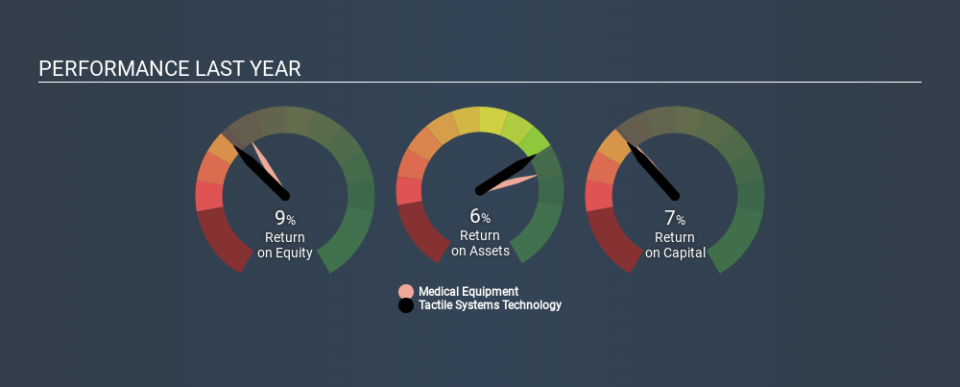Is Tactile Systems Technology, Inc. (NASDAQ:TCMD) Struggling With Its 7.0% Return On Capital Employed?

Today we are going to look at Tactile Systems Technology, Inc. (NASDAQ:TCMD) to see whether it might be an attractive investment prospect. To be precise, we'll consider its Return On Capital Employed (ROCE), as that will inform our view of the quality of the business.
First, we'll go over how we calculate ROCE. Next, we'll compare it to others in its industry. Last but not least, we'll look at what impact its current liabilities have on its ROCE.
Return On Capital Employed (ROCE): What is it?
ROCE measures the amount of pre-tax profits a company can generate from the capital employed in its business. Generally speaking a higher ROCE is better. Overall, it is a valuable metric that has its flaws. Author Edwin Whiting says to be careful when comparing the ROCE of different businesses, since 'No two businesses are exactly alike.
How Do You Calculate Return On Capital Employed?
Analysts use this formula to calculate return on capital employed:
Return on Capital Employed = Earnings Before Interest and Tax (EBIT) ÷ (Total Assets - Current Liabilities)
Or for Tactile Systems Technology:
0.07 = US$8.4m ÷ (US$144m - US$24m) (Based on the trailing twelve months to September 2019.)
Therefore, Tactile Systems Technology has an ROCE of 7.0%.
Check out our latest analysis for Tactile Systems Technology
Is Tactile Systems Technology's ROCE Good?
When making comparisons between similar businesses, investors may find ROCE useful. Using our data, Tactile Systems Technology's ROCE appears to be significantly below the 9.0% average in the Medical Equipment industry. This performance is not ideal, as it suggests the company may not be deploying its capital as effectively as some competitors. Separate from how Tactile Systems Technology stacks up against its industry, its ROCE in absolute terms is mediocre; relative to the returns on government bonds. Investors may wish to consider higher-performing investments.
The image below shows how Tactile Systems Technology's ROCE compares to its industry, and you can click it to see more detail on its past growth.
It is important to remember that ROCE shows past performance, and is not necessarily predictive. ROCE can be misleading for companies in cyclical industries, with returns looking impressive during the boom times, but very weak during the busts. This is because ROCE only looks at one year, instead of considering returns across a whole cycle. What happens in the future is pretty important for investors, so we have prepared a free report on analyst forecasts for Tactile Systems Technology.
Tactile Systems Technology's Current Liabilities And Their Impact On Its ROCE
Liabilities, such as supplier bills and bank overdrafts, are referred to as current liabilities if they need to be paid within 12 months. Due to the way the ROCE equation works, having large bills due in the near term can make it look as though a company has less capital employed, and thus a higher ROCE than usual. To counteract this, we check if a company has high current liabilities, relative to its total assets.
Tactile Systems Technology has total assets of US$144m and current liabilities of US$24m. As a result, its current liabilities are equal to approximately 17% of its total assets. It is good to see a restrained amount of current liabilities, as this limits the effect on ROCE.
What We Can Learn From Tactile Systems Technology's ROCE
With that in mind, we're not overly impressed with Tactile Systems Technology's ROCE, so it may not be the most appealing prospect. Of course, you might find a fantastic investment by looking at a few good candidates. So take a peek at this free list of companies with modest (or no) debt, trading on a P/E below 20.
If you like to buy stocks alongside management, then you might just love this free list of companies. (Hint: insiders have been buying them).
If you spot an error that warrants correction, please contact the editor at editorial-team@simplywallst.com. This article by Simply Wall St is general in nature. It does not constitute a recommendation to buy or sell any stock, and does not take account of your objectives, or your financial situation. Simply Wall St has no position in the stocks mentioned.
We aim to bring you long-term focused research analysis driven by fundamental data. Note that our analysis may not factor in the latest price-sensitive company announcements or qualitative material. Thank you for reading.

